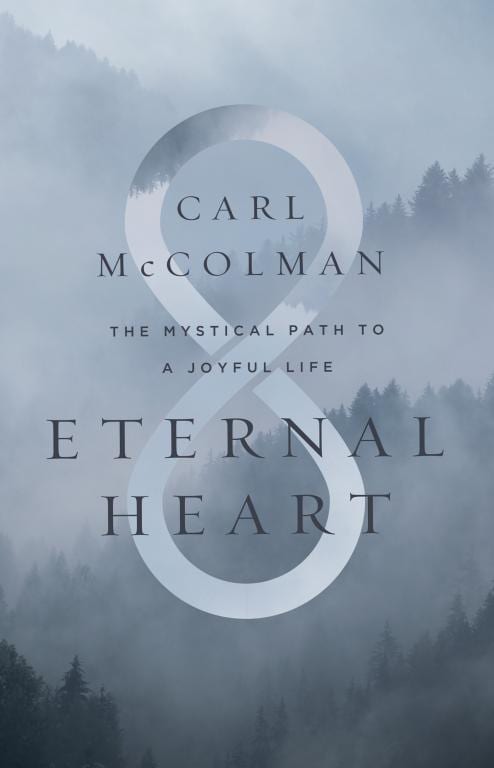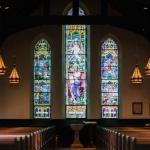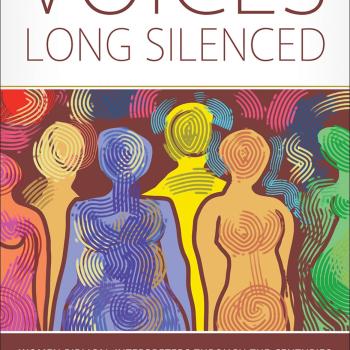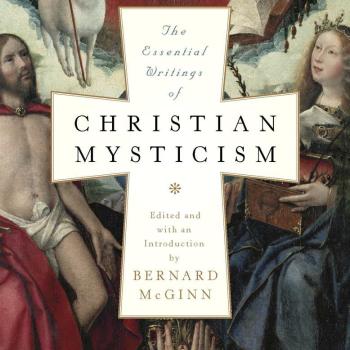N.B. Today’s guest post is by noted musician and thanatologist Therese Schroeder-Sheker. She wrote this piece in response to Carl McColman’s latest book, Eternal Heart.
I remember seeing an exquisite painting in a small private gallery in Brussels many years ago. Two souls were walking together side by side as the sun was setting in the west. Their heads were bowed, slightly inclined toward one another, and their glowing hands gestured gracefully like birds held aloft in mid-air. It seemed to me that something almost palpable was streaming from the painter’s canvas. Perhaps it was the intimacy of shared dialogue or maybe it was the tranquility generated from such noble mutuality, but either way, the image not only made my heart leap. It befriended me, embedded itself in me. I am not describing a sympathetic response to a pleasing aesthetic. Those tend to come and go speedily on the currents of emotion and unconscious cultural conditioning. No. This painterly image was speaking of something eternal, and everything about it activated an interior recollection, offering much about the unity of the three Transcendentals: Truth, Beauty and Goodness. When they are woven together in a single framework, they move mountains and sustain life.
Drawing close to this luminous source, I discovered that the painter had chosen to reference the work as Tobias and Raphael Walking Together at Dusk. The narrative of Tobias and Raphael is found in the Book of Tobit and tells a story of transformative healing. In it, the Archangel Raphael lovingly chooses to disguise himself as a human being so that two could speak with one another in trust, “shoulder-to-shoulder,” listening and responding. Conversation occurred organically, naturally, wisdom stirring amidst breathing cadences, silences and sounds. Raphael walks alongside the ailing Tobias and offers the exact kind of encouragement needed to help him heal and repair the gaps of his imperfect life.
During the last six-hundred years, this vision of the two walking together in sundown’s transformative communion has been taken up by many artists. Even so, the painting in front of me that day thirty-some years ago was a 20th century imagination, almost a vision, and I am so sorry that I cannot remember the name of the painter, nor can I find the image from any on-line search.
Regardless, that transcendent painting allowed me to remember how both Pythagorean and Christian Traditions once espoused the wisdom of walking together, two-by-two, shoulder-to-shoulder, rhythmically. Companions would walk together outside; they would walk in Nature, moving through forested groves, or across quiet fields, alongside lapping shorelines or over rugged landscapes. Two would walk together as part and parcel of a spiritual praxis and their mutually fructifying conversation allowed something new to come into being and sight. The walking cure invited a full spectrum of risking, trusting, uttering, listening, responding, questioning, grappling, suggesting, nurturing and encouraging. How powerfully true and intimate this time-honored embodiment of the intelligence of the heart. Two meet one another and grapple together over paradox and mystery, meaning and ultimacy, vulnerability and radiance, strength and tenderness, success and failure. The companions share affliction and the bread of insight.
The philosophical or theological debate from which so many of us emerge takes place in the confines of the beige-colored harshly lit classroom. Debate accommodates many people at the same time, emphasizes expertise, lauds brilliance, rewards competition, and begins and ends by the strict ticking of the clock. Nearby, a dean, abbot or abbess might have a fireside chat for a select few, the most promising and hardworking of the current students and emerging novices. Finally, we have the sermon. It is delivered from a raised platform or pulpit inside the enclosed church or synagogue. No matter how pastoral or inspired, the priest or rabbi stands. While vertical and elevated, the homilist speaks to a seated congregation. The listeners below, clustered with family, friends, neighbors, and dotted with solitary strangers have this in common: each receives the living word in silence. Some are fully awake and thoughtfully engaged, while famously, a few almost always snooze or let preoccupied thoughts wander. Such models offer the world much yet operate within institutional needs and collectives.
How different the soul’s companionship. The footsteps of two tread the earth in open friendship, treading at the same pace, at the same elevation, and gradually, synchronization takes place. The originally separate drumming of heartbeat and pulse begin to transform because the two companions are breathing together. The originally differentiated circulatory systems begin to harmonize, and as attunement begins to unfold, a mysterious third possibility emerges. Some would even say that the mysterious presence of the third takes place. No wonder St. Augustine said “Solvitur ambulando” – it is solved by walking.

By the time you have completed reading the fourth chapter of Carl McColman’s Eternal Heart, you may discover that you can hear his voice and that you are being accompanied! His modest, warm, gracious companionship fills your room not only because he reflects upon things that matter but because his eight chapters emerge naturally. The voice is authentic, resounding at a breathing tempo, at a walking pace, not unlike when two are shoulder-to-shoulder, in loving and thoughtful sustained conversation. His reflections sound at the octave rather than at a tonic, because they are born from embodied and ensouled human experience. Ambitious scholarly summations, talking heads abstraction and doctrinaire rigidity are absent from these pages, and instead, the author is at peace with referring sometimes to one of the historical exemplars in the same way that a painter might introduce a single brushstroke or a nuanced hue to draw attention to and amplify a certain reality.
Precisely because of the quality of his ability to companion, McColman demonstrates and integrates the wisdom born of his own movement through the sacrament of failure. He does this while avoiding the sensationalism of extravagant disclosure. Exploring themes as lofty as infinity, as complex as discernment, as deep as silence or forgiveness, as creative as hospitality, as uncomfortable as stinginess, as timeless as love, he quietly, lovingly, naturally, rhythmically and prayerfully introduces readers to profound themes, practical exercises and beloved friends. He brings us those people whom he has taken into his own heart and life, and to whom he has given of himself, at times, at great cost. He also shares with us those praxes which have been personally purifying, transformative and regenerative. His friends include the Greeks, the Jews, the Christians, the Buddhists, Cistercians, Trappists, Benedictines and more. They include Plotinus, Julian of Norwich, Ignatius of Loyola, Benedict, Augustine, Abraham Joshua Heschel, Thomas Merton, William Blake, Paramahansa Yogananda, Sylvia Boorstein, Caryll Houselander, Rabbi Zalman Schacter, the prophets, the saints, the faithful, all of whom are ultimately and gloriously subversive.
Like that painting on the wall that depicted how the archangel once descended to companion a human, Eternal Heart is a work of humanly sung companionship. The year 2021 may seem to operate at the crossroads of urgency and probation, so this book is as timely as it is transcendent. The author reminds us that becoming more truly human is not only the first step toward the mystical vocation; it is the primary practical assignment of life on earth and the first step toward a fruitful and contemporary holiness. I am writing these words amidst the pandemic; all norms have been disrupted. Many across the globe have entered solitude by choice and by default, and many are searching deeply, wanting to recalibrate, in need of an extended spiritual retreat. Sister Wendy Becket once described prayer as God’s taking possession of us. “We expose Him,“ she said, “to what we are, and He gazes on us with the creative eye of Holy Love.” My sense of things is that Carl McColman’s open door and warm companionship will direct many sincere readers to a radical rediscovery of essentials both mystical and transcendent. Read this unpretentious book slowly and prayerfully. It teaches metanoia and kenosis in the most practical ways. Enter into sustained conversation with the author, as if you were walking together with him in a meadow. The influence of the healing angel who can help us repair our fragmentation can be found in these quiet pages, precisely because of the creative eye of holy love, an ensouled capacity that Carl McColman inhabits and shares with all.
— Therese Schroeder-Sheker, Candlemas 2021.
 About the Author: Harpist, singer and composer Therese Schroeder-Sheker has devoted more than forty years to serving the physical and spiritual needs of the dying with prescriptive music. Ms. Schroeder-Sheker founded the palliative medical modality of music-thanatology and The Chalice of Repose Project, the first music-thanatology organization in the world. Her beautiful and award-winning recordings include The Queen’s Minstrel, Rosa Mystica, and The Geography of the Soul. She is the author of Transitus: A Blessed Death in the Modern World. As the title of that book suggests, her work has a contemplative dimension that explores how music can be a gift to those who are dying or in hospice or palliative care.
About the Author: Harpist, singer and composer Therese Schroeder-Sheker has devoted more than forty years to serving the physical and spiritual needs of the dying with prescriptive music. Ms. Schroeder-Sheker founded the palliative medical modality of music-thanatology and The Chalice of Repose Project, the first music-thanatology organization in the world. Her beautiful and award-winning recordings include The Queen’s Minstrel, Rosa Mystica, and The Geography of the Soul. She is the author of Transitus: A Blessed Death in the Modern World. As the title of that book suggests, her work has a contemplative dimension that explores how music can be a gift to those who are dying or in hospice or palliative care.













